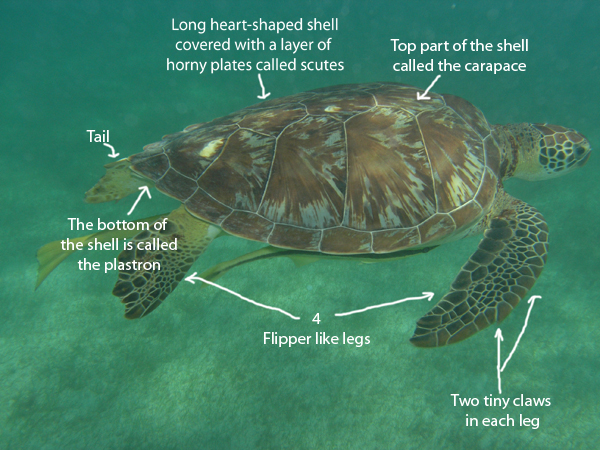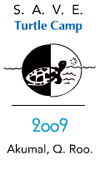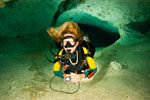The Sea Turtles

Sea Turtles have swum peacefully through the world’s oceans for millions of year. Sadly, however, these beautiful reptiles are now threatened with extinction due to hunting, capture in fisheries, coastal over-development, beach degradation, and marine pollution. Sea Turtles, except for the short time that they climb onto sandy beaches to dig nests and lay their eggs, spend their time swimming the oceans of the world. They tend to be located in shallow coastal waters of warm and temperate seas, but they also will swim the deep colder oceans, mostly alone. There are seven types of sea turtles, including the local Loggerhead (Caretta caretta), the Green Turtle (Chelonia mydas), the Leatherback (Dermochelys coriacea), Hawksbill (Eretmochelys imbricate). All Sea Turtle species are considered endangered or threatened both in Mexico and internationally.
Anatomy: These cold-blooded animals are strong swimmers and good divers. They have four flipper-like legs and a shell that is attached to their backbone. They cannot pull their head and legs into the shell. These turtles vary in color from shades of brown to green to black. Sea turtles vary in size from 2 to 6 feet (0.5 to 1.9 m) long, weighing 78 to 1900 pounds (35 to 870 kg). During active times, turtles must go to the sea's surface every few minutes in order to breathe air.
Diet: Most sea turtles are carnivores (meat eaters), but the green turtle is a herbivore (a plant eater that eats sea grass and algae). Most sea turtles eat crustaceans (crabs, lobster, shrimp, and other shelled invertebrates), shellfish, jellyfish, man-o-wars, and small fish.
Reproduction: Adult female Sea Turtles return to the beach where they were born to lay up to 200 soft-shelled eggs in the sand. When the baby turtles hatch (approx. 60 days later), they immediately head for the nearby water, using the moon for direction. Most young turtles are eaten bybirds and other predators during this difficult trip to the deep ocean. It has been estimated that only 1% of these hatchlings will reach adulthood. The baby hatchlings will smell and feel the sand as they make their way to the sea. This is how they will remember to return to the same beach, for their entire lives. There are two turtles that nest in Aventuras-DIF Beach, the Green and the Loggerhead. Akumal literal means in Maya “place of the turtles”.
Green Sea Turtles: populations migrate primarily along the coasts from nesting to feeding grounds. However, some populations will travel 1,300miles (2,094 km) across the Atlantic Ocean from the Ascension Island nesting grounds to the Brazilian coast feeding grounds.
Loggerheads: leave foraging areas and travel on breeding migrations that range from a few to thousands of miles.
More information
The Mexican State of Quintana Roo, has 14 areas legally protected by state or federal legislation. Two areas belong to the continental zone and the other 12 to the coastal zone, in which are found important sea turtles nesting sites. Yum-balam, Isla Contoy and Sian Kaán Biosphere reserve are hawksbill (Eretmochelys imbricate) nesting sites. Green (Chelonia Mydas) and loggerhead (Caretta Caretta) nest at these sites as well as on the eastern part of Isla Cozumel and Tulum National Park. Studies have been conducted that determined that the beaches with the greatest density of turtle nests in the area are: Chemuyil, X'cacel and Aventuras DIF; inaddition they recommended legal actions to be taken for their protection due to their biological characteristics, their bio-geographic importance, their state of conservation, and the threat that prevails within the tourist corridor Cancún – Tulum, the Riviera Maya. Both Green and Loggerhead sea turtles are considered under protection by the Mexican laws and by international conventions. But both species are in danger of extinction, due to damage oftheir beach nesting grounds, including:
- Erosion of dunes.
- Disturbance of the vegetation that controls the flow of water.
- Contamination and alterations of the physical,chemical and biological characteristics of the beaches. Some in the form of Geotube membranes, which are large plastic-vinyl bean bag type sacks used to stop erosion, weathering in the water, falling apart, creating a danger for all aquatic life.
- Disturbance of nesting female turtles and their nests.
- Disturbance caused by the artificial illumination of the beach and adjacent areas.
- Disturbance caused by noises generated by aquatic activities and while they are nesting.
- Disturbances in the reef and its platform,potentially able to alter the water flow.
- Cementing beaches with local sascab, a major cement export of Quintana Roo, just add sand and water. This absolutely limits the diggi
 ng of turtle nests.
ng of turtle nests.
There is increasing pressure to develop this area for tourism. All or parts of these three critical beaches (Chemuyil, Aventuras-DIF and X’cacel) have recently been sold with plans for building. The risk of losing all important nesting sites for the green and loggerhead turtles is real. One needs to consider the effects of the constructions for tourist infrastructures versus the turtles that have been coming to this same beach to lay their eggs, year after year for millions of years.
We at SAVE recommend an overhaul of the environmental impact studies and a permanent monitoring of development in these areas. We recommend and are pursuing Federal sanctuary status for playa Xcacel / Xcacelito. This area is vital to sea turtle reproduction and needs to be protected in a meaningful way.
.



